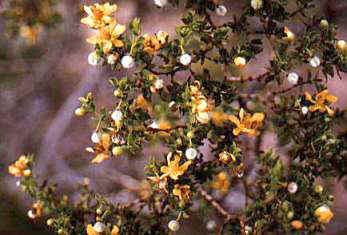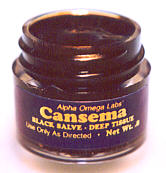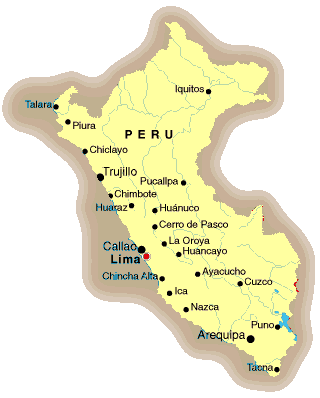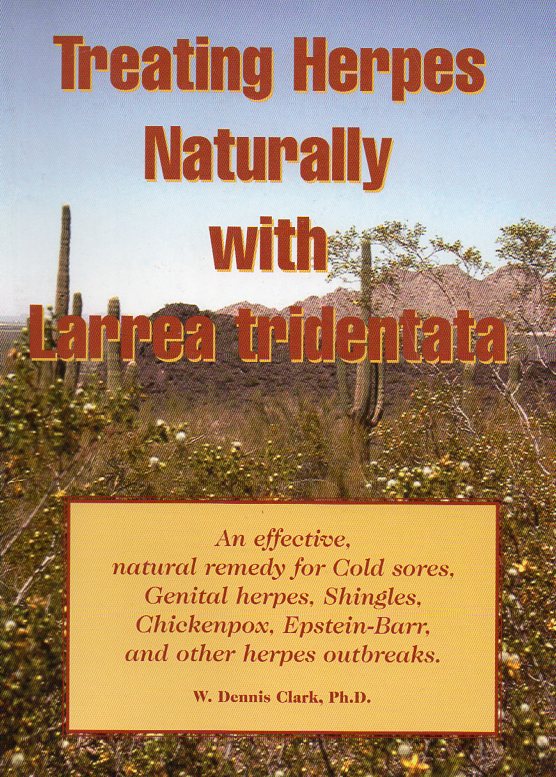|
Herpes Virus (All Types), Arthritis, Rheumatism
Chaparral

S. American Chaparral
(Larrea divaricata)
Pulvarized Leaves of "Hembra Jarilla"
Chaparral Tea
Code 325 -- Price: $4.95
Pulverized leaves: 85 gr. (net wt)
Makes About 6 Liters of Tea
(Using 15 g. or 2.5 T.
to make one liter / quart)
Chaparral Capsules : Code 325C -- $14.50
(100 x 260 mg. veggie capsules)
Order Now
 Email
Email
 Summarized Description:
Chaparral Summarized Description:
Chaparral is a
traditional in South America,
where the species here, Larrea divaricata, corresponds to
Larrea tridentata in the U.S. and Mexico. It is better known
as "Hembra jarilla" in the deserts of native Peru, where we have
the leaves wildcrafted and milled.

 Alpha Omega Labs Alpha Omega Labs
was the first company to popularize the use of chaparral in escharotic
preparations, beginning in 1990 -- and then at an accelerated pace
when we introduced Cansema on the internet in September, 1995.
(A history is provided in Chapters 1 through 3 in
Meditopia.)
 The entire
Larrea
genus is extraordinarily hardy, living in harsh desert climates
for up to
12,000 years. Undoubtedly, indigenous peoples much have deduced its
extraordinarily medicinal properties after observing that, unlike other
plants, Larrea doesn't have any predators. Its massive array of
protective phytochemicals (primarily lignans and flavonoids) keeps away
viruses, bacteria, fungi, competitor plants, insects, and rodents.
The only exception are small lizards, which eat the flowers when in bloom.
 Unlike most of the other offerings
in our medical tea category, this product comes pulverized, for maximum
diffusion of the active principles (in tea) and absorption if made into
capsules. A daily therapeutic dosage would be approximately 300 mg.
 The "tea leaves" in this product
are so finely pulverized that many users may simply choose to drink
with the tea and forego straining. An important note on preparation :
the don't call chaparral "creosote bush" in the U.S. for nothing.
The taste -- for the vast majority is quite off-putting -- so you
will probably elect to improve with honey and lemon.
 Instructions / Dosages: Instructions / Dosages: Do not
give to children under 12 years of age. Adult dosage: One capsule per day to start.
After three days, graduate to one capsule, 2x a day. Between the ages of 12 and 18,
no more than one capsule daily.
Shelf-Life
 We know of no medical herb that has
a shelf-life that compares to chaparral. We tell customers "ten years,"
because we've used dried chaparral of that age without ill consequence,
as the Salves from which chaparral is made also have a confirmed shelf-life
of this span. The truth is that we really don't know the true shelf-life,
because we've never heard of any "going bad" -- not in our own lab experience
nor in the extant literature. Moreover -- and just as amazing -- we have
not seen any variation of powdered chaparral leaf lose potency over time. We know of no medical herb that has
a shelf-life that compares to chaparral. We tell customers "ten years,"
because we've used dried chaparral of that age without ill consequence,
as the Salves from which chaparral is made also have a confirmed shelf-life
of this span. The truth is that we really don't know the true shelf-life,
because we've never heard of any "going bad" -- not in our own lab experience
nor in the extant literature. Moreover -- and just as amazing -- we have
not seen any variation of powdered chaparral leaf lose potency over time.
Medical Properties
 For this product, we cite the
ethnobotanical findings of W. Dennis Clark, Ph.D., in monograph,
"Treating Herpes Naturally with Larrea tridentata." (See additional
comments in the column at right.) The title of the book
is somewhat deceptive. Clark covers many other ailments, unrelated to
herpes, and he provides excellent references. Moreover, as the
chemical profiles of "tridentata" and "divaricata" are nearly
identical, it should come as no surprise that both varieties
have the same uses on their respective continents. We recommend
the purchase of the book on Amazon for those interested
in further study of chaparral's many properties. Clark
derives the medical uses below from a database maintained by
The University of Michigan.
We wish to remind the reader that these are ethnobotanical
uses and not curative representations made by Alpha Omega Labs: For this product, we cite the
ethnobotanical findings of W. Dennis Clark, Ph.D., in monograph,
"Treating Herpes Naturally with Larrea tridentata." (See additional
comments in the column at right.) The title of the book
is somewhat deceptive. Clark covers many other ailments, unrelated to
herpes, and he provides excellent references. Moreover, as the
chemical profiles of "tridentata" and "divaricata" are nearly
identical, it should come as no surprise that both varieties
have the same uses on their respective continents. We recommend
the purchase of the book on Amazon for those interested
in further study of chaparral's many properties. Clark
derives the medical uses below from a database maintained by
The University of Michigan.
We wish to remind the reader that these are ethnobotanical
uses and not curative representations made by Alpha Omega Labs:
 ARTHRITIS, RHEUMATISM and PAINFUL JOINTS -- EXTERNAL ARTHRITIS, RHEUMATISM and PAINFUL JOINTS -- EXTERNAL
- Cahuilla -- Plant made into liniment used by elderly people for swollen limbs caused
by poor blood circulation
- Diegueno -- Decoction of leaves used as a bath for rheumatism, painful arthritis,
aching bones and sprains
- Kawaiisu -- Decoction of leaves used as a wash for sore and aching parts of the body
- Kawaiisu -- Poultice of heated leaves applied to aching limbs
- Isleta -- Dedoction of leaves used as a body bath for rheumatism
- Paiute -- Infusion of leaves used as a wash for rheumatism.
- Papago -- Plant used for stiff limbs
- Papago -- Green branches laid on ashes, aching feet and stiff limbs held in smoke
- Papago -- Smoke from smoldering green branches applied for rheumatism and to joints
- Pima -- Infusion of leaves taken for pain or used as bath and rub for rheumatic pains
- Pima -- Poultice of heated branches and leaves applied for pain
- Pima -- Infusion of leaves used as bath and rub or poultice applied to rheumatic pains
- Yavapai -- Decoction of leaves and stems used as wash for rheumatism
 ASTHMA, CONGESTION, CHEST INFECTIONS ASTHMA, CONGESTION, CHEST INFECTIONS
- Cahuilla -- Infusion of stems and leaves used for chest infections
- Cahuilla -- Infusion of stems and leaves used as a decongestant for clearing lungs
- Cahuilla -- Leaves boiled or heated and the steam inhaled for congestion
- Hualapai -- Infusion of leaves taken or leaves steamed for congestion and asthma
 BOWEL PROBLEMS BOWEL PROBLEMS
- Cahuilla -- Infusion of stems and leaves used for bowel complaints
- Coahuilla -- Infusion of leaves taken for bowel complaints and consumption
- Mahuna -- Plant used for stomach cramps from delayed menstruation
- Paiute -- Decoction of leaves taken for bowel cramps
- Pima -- Decoction of branches taken for gas caused by upset stomach or gas pains
- Pima -- Plant gum chewed and swallowed as an antidysenteric and intestinal antispasmodic
- Pima -- Decoction of plant taken for stomachaches and cramps
- Pima -- Plant gum chewed and swallowed as an intestinal antispasmodic
 CANCER CANCER
- Cahuilla -- Infusion of stems and leaves used for cancer
 CHICKENPOX CHICKENPOX
- Paiute -- Infusion of leaves used as a wash for chickenpox.
 COLD MEDICINE COLD MEDICINE
- Cahuilla -- Infusion of stems and leaves used for colds
- Hualapai -- Infusion of leaves taken or leaves steamed for colds
- Paiute -- Decoction or infusion of leaves taken as a cold medicine
- Pima -- Decoction of plant resin taken for colds
- Shoshoni -- Decoction of leaves taken for colds
- Yavapai -- Decoction of leaves and stems taken for sore throat
 DISINFECTANT / ANTISEPTIC DISINFECTANT / ANTISEPTIC
- Cahuilla -- Infusion of stems and leaves used to draw out poisons and for infections
- Hualapai -- Infusion of leaves used as a disinfecting skin cleanser
- Isleta -- Decoction of leaves used as a disinfectant
- Kawaiisu -- Plant used for antiseptic properties
- Mahuna -- Infusion of plant used as a disinfectant and deodorizer
 DIURETIC DIURETIC
- Pima Drug -- Infusion of leaves taken for dysuria (difficulty in passing urine)
- Shoshoni -- Decoction of leaves taken to "stimulate urination."
 EMETIC EMETIC
- Cahuilla -- Infusion of stems and leaves used, in heavy doses, to induce vomiting
- Papago -- Decoction of leaves taken as an emetic
- Pima Drug -- Decoction of leaves taken as an emetic
- Pima -- Decoction of leaves taken as an emetic for high fevers
 GENERAL MEDICAL USE GENERAL MEDICAL USE
- Pima -- Plant used to cure everthing
- Kawaiisu -- Plant used for medicinal purposes
- Pima -- Smoke from plant used for weakness and laziness
- Pima -- Poultice of boiled leaves used for unspecified purpose
- Cahuilla -- Infusion of stems and leaves mixed with honey and used as a general health tonic before breakfast
- Paiute -- Plant used for many different illnesses and ocnsidered a "cure-all."
 GYNECOLOGICAL AID GYNECOLOGICAL AID
- Cahuilla -- Infusion of stems and leaves used for stomach cramps from delayed menstruation
- Papago -- Branches used as bed for women with menstrual cramps or after childbirth
- Papago -- Infusion of leaves used on breasts to start milk flow
- Papago -- Poultice of heated branches applied to facilitate childbirth
 ORAL RINSE, TOOTHACHE ORAL RINSE, TOOTHACHE
- Pima -- Decoction of gum used as a gargle
- Pima -- Infusion of plant held in the mouth for toothaches
 PAIN, HEADACHE & FEVER -- INTERNAL PAIN, HEADACHE & FEVER -- INTERNAL
- Paiute -- Decoction of leaves taken for bowel cramps
- Pima -- Decoction of leaves taken as an emetic for high fevers
- Pima -- Decoction of twigs taken for gas pains or headaches caused by upset stomaches
 SKIN DISORDERS SKIN DISORDERS
- Cahuilla -- Crushed leaf powder applied to sores and wounds
- Cahuilla -- Decoction or poultice of leaves used on open wounds
- Isleta -- Leaves used in shoes to absorb moisture
- Mahuna -- Infusion of plant used for dandruff
- Paiute -- Compound decoction of leaves with badger oil used as a salve for burns
- Paiute -- Dried, powdered leaves sprinkled on sores
- Papago -- Plant used for poisonous bites and sores
- Papago -- Dried, powdered leaf rubbed on infant's navel to promote healing
- Papago -- Poultice of chewed leaves placed on insect bites, spider bites, scorpion bites,
snakebites and sores.
- Pima -- Infusion of plant used as wash for impetigo sores or dandrugg
- Yavapai -- Decoction of leaves and stems used as a wash for cuts and sores
- Yavapai -- Dried, pulverized leaves used for sores
 TUBERCULOSIS TUBERCULOSIS
- Coahuilla -- Infusion of leaves taken for consumption and bowel complaints
- Pima -- Decoction of gum taken for tuberculosis
 VENEREAL DISEASE VENEREAL DISEASE
- Paiute -- Compound decoction of leaves taken for gonorrhea
- Shoshoni -- Decoction of leaves taken for venereal disease
- Yavapai -- Decoction of leaves and stems used as a wash for gonorrhea
- Yavapai -- Whole leaves used on penis for gonorrhea
 VETERINARY VETERINARY
- Coahuilla -- Plant given to horses for colds, distemper or runny nose
- Kawaiisu -- Decoction of leaves used for collar sores on draft animals
|
 To U.S. Users: To U.S. Users: This product
have not been evaluated by the U.S. Food & Drug Administration.
It is not intended to diagnose, treat, cure, or prevent any disease.
|
 "Hembra Jarilla",
as South American chaparral is called in Peru, grows wild
in the deserts of that country, where we have the plant
wildcrafted and milled for our specifications -- for this product
and as an ingredient in Cansema
Black Topical Salves. "Hembra Jarilla",
as South American chaparral is called in Peru, grows wild
in the deserts of that country, where we have the plant
wildcrafted and milled for our specifications -- for this product
and as an ingredient in Cansema
Black Topical Salves.
 Medical uses described
in the column at left are taken from W. Dennis Clark's book,
"Treating Herpes Naturally with Larrea tridentata." (p. 50-52) Medical uses described
in the column at left are taken from W. Dennis Clark's book,
"Treating Herpes Naturally with Larrea tridentata." (p. 50-52)
 The tribes in North America
where the plant is native with documented uses
include: The tribes in North America
where the plant is native with documented uses
include:
- Arizona -- Papago, Pima, Yavapai, Hualapai
- California -- Coahuilla, Diegueno, Kawaiisu, Mahuna
- Nevada -- Paiute, Shoshoni
- New Mexico -- Isleta
Chaparral --- A
Personal Journey
[ Greg Caton ]
 In the summer of 1963, I asked
my parents if I could go on a YMCA camping trip as part of my
summer vacation. Back in those days,
parents in the Los Angeles area could send their children on a
supervised trek through the arid desert lands outside the county
for $15 a week. In the summer of 1963, I asked
my parents if I could go on a YMCA camping trip as part of my
summer vacation. Back in those days,
parents in the Los Angeles area could send their children on a
supervised trek through the arid desert lands outside the county
for $15 a week.
 At the time, I was only
seven years old, and this would be the longest time I had ever
spent away from my parents. I took some supplies, toiletries,
a brown, cotton, sleeping bag, and off I went. (I did this
for three weeks.) At the time, I was only
seven years old, and this would be the longest time I had ever
spent away from my parents. I took some supplies, toiletries,
a brown, cotton, sleeping bag, and off I went. (I did this
for three weeks.)
 The guides were there not
just to supervise their young cohort, but to educate them, as well.
They taught us about different flora and fauna. How to survive
in the wilderness. Wild plants you could eat and what plants to avoid . . .
so many things . . . things I have long forgotten. The guides were there not
just to supervise their young cohort, but to educate them, as well.
They taught us about different flora and fauna. How to survive
in the wilderness. Wild plants you could eat and what plants to avoid . . .
so many things . . . things I have long forgotten.
 Except one. Except one.
 The unmistakeable smell
of chapparal. The unmistakeable smell
of chapparal.
 It was as if it defined the place, haunting me so
that even as a child I would stop walking when I caught a whiff
with the soft desert breeze. In fact, years later I forgot the
name of the plant, but I remembered that smell . . .so much so,
it was hard to imagine being in the desert and not feeling its presence. It was as if it defined the place, haunting me so
that even as a child I would stop walking when I caught a whiff
with the soft desert breeze. In fact, years later I forgot the
name of the plant, but I remembered that smell . . .so much so,
it was hard to imagine being in the desert and not feeling its presence.
 Twenty-six years later,
I encountered this plant again -- in Louisiana -- a place where
the plant doesn't even grow. As an apprentice studying under
Dr. Russell Jordan (see Chapter
One of Meditopia), I learned of its medicinal properties and
found myself as if reconnected to an old friend . . . having
first met when I was too young to have comprehended what this plant
would teach me . . . too young to have known that at some point in
the future I would be a practicing herbalist. Twenty-six years later,
I encountered this plant again -- in Louisiana -- a place where
the plant doesn't even grow. As an apprentice studying under
Dr. Russell Jordan (see Chapter
One of Meditopia), I learned of its medicinal properties and
found myself as if reconnected to an old friend . . . having
first met when I was too young to have comprehended what this plant
would teach me . . . too young to have known that at some point in
the future I would be a practicing herbalist.
 We all know that people can
have a special relation with an animal -- a beloved pet. There are
even people who look like their animals. I sometimes wonder if
people realize that we can have relationships with our plants,
as well. . . that just as we can have unique ties to other people
and animals, we can share special bonds with plants. We all know that people can
have a special relation with an animal -- a beloved pet. There are
even people who look like their animals. I sometimes wonder if
people realize that we can have relationships with our plants,
as well. . . that just as we can have unique ties to other people
and animals, we can share special bonds with plants.
 The very concept might
have missed me had I not had this unique experience with
an exceptional desert plant. To contemplate its very spirit, gives me pause. The very concept might
have missed me had I not had this unique experience with
an exceptional desert plant. To contemplate its very spirit, gives me pause.

|


 ARTHRITIS, RHEUMATISM and PAINFUL JOINTS -- EXTERNAL
ARTHRITIS, RHEUMATISM and PAINFUL JOINTS -- EXTERNAL ASTHMA, CONGESTION, CHEST INFECTIONS
ASTHMA, CONGESTION, CHEST INFECTIONS BOWEL PROBLEMS
BOWEL PROBLEMS CANCER
CANCER CHICKENPOX
CHICKENPOX COLD MEDICINE
COLD MEDICINE DISINFECTANT / ANTISEPTIC
DISINFECTANT / ANTISEPTIC DIURETIC
DIURETIC EMETIC
EMETIC GENERAL MEDICAL USE
GENERAL MEDICAL USE GYNECOLOGICAL AID
GYNECOLOGICAL AID ORAL RINSE, TOOTHACHE
ORAL RINSE, TOOTHACHE PAIN, HEADACHE & FEVER -- INTERNAL
PAIN, HEADACHE & FEVER -- INTERNAL SKIN DISORDERS
SKIN DISORDERS TUBERCULOSIS
TUBERCULOSIS VENEREAL DISEASE
VENEREAL DISEASE VETERINARY
VETERINARY

